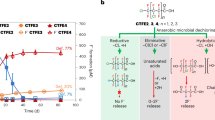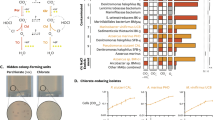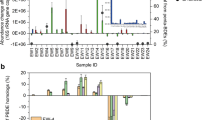Abstract
Polychlorinated dibenzo-p-dioxins and dibenzofurans (PCDDs and PCDFs) are among the most notorious environmental pollutants. Some congeners, particularly those with lateral chlorine substitutions at positions 2, 3, 7 and 8, are extremely toxic and carcinogenic to humans1. One particularly promising mechanism for the detoxification of PCDDs and PCDFs is microbial reductive dechlorination. So far only a limited number of phylogenetically diverse anaerobic bacteria have been found that couple the reductive dehalogenation of chlorinated compounds—the substitution of a chlorine for a hydrogen atom—to energy conservation and growth in a process called dehalorespiration2. Microbial dechlorination of PCDDs occurs in sediments and anaerobic mixed cultures from sediments, but the responsible organisms have not yet been identified or isolated. Here we show the presence of a Dehalococcoides species in four dioxin-dechlorinating enrichment cultures from a freshwater sediment highly contaminated with PCDDs and PCDFs. We also show that the previously described chlorobenzene-dehalorespiring bacterium Dehalococcoides sp. strain CBDB1 (ref. 3) is able to reductively dechlorinate selected dioxin congeners. Reductive dechlorination of 1,2,3,7,8-pentachlorodibenzo-p-dioxin (PeCDD) demonstrates that environmentally significant dioxins are attacked by this bacterium.
This is a preview of subscription content, access via your institution
Access options
Subscribe to this journal
Receive 51 print issues and online access
$199.00 per year
only $3.90 per issue
Buy this article
- Purchase on Springer Link
- Instant access to full article PDF
Prices may be subject to local taxes which are calculated during checkout



Similar content being viewed by others
References
Kaiser, J. Just how bad is dioxin? Science 288, 1941–1944 (2000)
Holliger, C., Wohlfarth, G. & Diekert, G. Reductive dechlorination in the energy metabolism of anaerobic bacteria. FEMS Microbiol. Rev. 22, 383–398 (1999)
Adrian, L., Szewzyk, U., Wecke, J. & Görisch, H. Bacterial dehalorespiration with chlorinated benzenes. Nature 408, 580–583 (2000)
Brzuzy, L. P. & Hites, R. A. Global mass balance for polychlorinated dibenzo-p-dioxins and dibenzofurans. Environ. Sci. Technol. 30, 1797–1804 (1996)
Meharg, A. A. & Osborn, D. Dioxins released from chemical accidents. Nature 375, 353–354 (1995)
Gribble, G. W. Encyclopedia of Environmental Analysis and Remediation (ed. Meyers, R. A.) 972–1035 (Wiley, New York, 1998)
Hoekstra, E. J., de Weerd, H., de Leer, E. W. B. & Brinkman, U. A. T. Natural formation of chlorinated phenols, dibenzo-p-dioxins, and dibenzofurans in soil of a Douglas fir forest. Environ. Sci. Technol. 33, 2543–2549 (1999)
Rappe, C. et al. PCDDs in naturally-formed lake sediment cores from Southern Mississippi, USA. Organohalogen Comp. 43, 111–116 (1999)
Müller, J. F. et al. PCDDs, PCDFs, PCBs and HCB in marine and estuarine sediments from Queensland, Australia. Chemosphere 39, 1707–1721 (1999)
Adriaens, P. & Grbic-Galic, D. Reductive dechlorination of PCDD/F by anaerobic cultures and sediments. Chemosphere 29, 2253–2259 (1994)
Adriaens, P., Fu, Q. & Grbic-Galic, D. Bioavailability and transformation of highly chlorinated dibenzo-p-dioxins and dibenzofurans in anaerobic soils and sediments. Environ. Sci. Technol. 29, 2252–2260 (1995)
Beurskens, J. E. M. et al. Dehalogenation of chlorinated dioxins by an anaerobic microbial consortium from sediment. Environ. Toxicol. Chem. 14, 939–943 (1995)
Barkovskii, A. L. & Adriaens, P. Microbial dechlorination of historically present and freshly spiked chlorinated dioxins and diversity of dioxin dechlorinating populations. Appl. Environ. Microbiol. 62, 4556–4562 (1996)
Ballerstedt, H., Kraus, A. & Lechner, U. Reductive dechlorination of 1,2,3,4-tetrachlorodibenzo-p-dioxin and its products by anaerobic mixed cultures from Saale River sediment. Environ. Sci. Technol. 31, 1749–1753 (1997)
Albrecht, I. D., Barkovskii, A. L. & Adriaens, P. Production and dechlorination of 2,3,7,8-tetrachlorodibenzo-p-dioxin in historically-contaminated estuarine sediments. Environ. Sci. Technol. 33, 737–744 (1999)
Beurskens, J. E. M., Mol, G. A. J., Barreveld, H. L., van Munster, B. & Winkels, H. J. Geochronology of priority pollutants in a sedimentation area of the Rhine River. Environ. Toxicol. Chem. 12, 1549–1566 (1993)
Bunge, M., Ballerstedt, H. & Lechner, U. Regiospecific dechlorination of spiked tetra- and trichlorodibenzo-p-dioxins by anaerobic bacteria from PCDD/F-contaminated Spittelwasser sediments. Chemosphere 43, 675–681 (2001)
Maymó-Gatell, X., Chien, Y., Gossett, J. M. & Zinder, S. H. Isolation of a bacterium that reductively dechlorinates tetrachloroethene to ethene. Science 276, 1568–1571 (1997)
Dojka, M. A., Hugenholtz, P., Haack, S. K. & Pace, N. R. Microbial diversity in a hydrocarbon- and chlorinated-solvent-contaminated aquifer undergoing intrinsic bioremediation. Appl. Environ. Microbiol. 64, 3869–3877 (1998)
Hendrickson, E. R. et al. Molecular analysis of Dehalococcoides 16S ribosomal DNA from chloroethene-contaminated sites throughout North America and Europe. Appl. Environ. Microbiol. 68, 485–495 (2002)
von Wintzingerode, F., Selent, B., Hegemann, W. & Göbel, U. B. Phylogenetic analysis of an anaerobic, trichlorobenzene-transforming microbial consortium. Appl. Environ. Microbiol. 65, 283–286 (1999)
Löffler, F. E., Sun, Q., Li, J. & Tiedje, J. M. 16S rRNA gene-based detection of tetrachloroethene-dechlorinating Desulfuromonas and Dehalococcoides species. Appl. Environ. Microbiol. 66, 1369–1374 (2000)
Wu, Q., Watts, J. E. M., Sowers, K. R. & May, H. D. Identification of a bacterium that specifically catalyzes the reductive dechlorination of polychlorinated biphenyls with doubly flanked chlorines. Appl. Environ. Microbiol. 68, 807–812 (2002)
Cutter, L. A., Watts, J. E. M., Sowers, K. R. & May, H. D. Identification of a microorganism that links its growth to the reductive dechlorination of 2,3,5,6-chlorobiphenyl. Environ. Microbiol. 3, 699–709 (2001)
Ballschmiter, K., Zoller, W., Schäfer, W. & Class, T. Quantitation of polychlorodibenzodioxin and polychlorobiphenyl standards by gas-chromatography-flame ionisation detection. Fresenius Z. Anal. Chem. 321, 247–251 (1985)
DIN EN 1948-3 Stationary source emissions—determination of the mass concentration of PCDDs/PCDFs. Part 3. Identification and quantification (Beuth, Berlin, 1997)
Breitenstein, A., Saano, A., Salkinoja-Salonen, M., Andreesen, J. R. & Lechner, U. Analysis of a 2,4,6-trichlorophenol-dehalogenating enrichment culture and isolation of the dehalogenating member Desulfitobacteriun frappieri strain TCP-A. Arch. Microbiol. 175, 133–142 (2001)
Ludwig, W. et al. Bacterial phylogeny based on comparative sequence analysis. Electrophoresis 19, 554–568 (1998)
Acknowledgements
We thank R. Weber for providing standards for 1,2-, 1,3- and 1,4-DiCDD; M. M. Häggblom and R. U. Halden for comments on the manuscript; and H. Ballerstedt for helpful discussion and support. This work was supported by grants of the Land Sachsen-Anhalt and the Deutsche Forschungsgemeinschaft to U.L. and M.B., of the Technische Universität Berlin to L.A. and of the Fonds der Chemischen Industrie to J.R.A.
Author information
Authors and Affiliations
Corresponding author
Ethics declarations
Competing interests
The authors declare that they have no competing financial interests.
Rights and permissions
About this article
Cite this article
Bunge, M., Adrian, L., Kraus, A. et al. Reductive dehalogenation of chlorinated dioxins by an anaerobic bacterium. Nature 421, 357–360 (2003). https://doi.org/10.1038/nature01237
Received:
Accepted:
Issue Date:
DOI: https://doi.org/10.1038/nature01237
This article is cited by
-
Distribution of PCDD/Fs in a food waste anaerobic digestion process with biogas utilization
Frontiers of Environmental Science & Engineering (2023)
-
Integration of microbial reductive dehalogenation with persulfate activation and oxidation (Bio-RD-PAO) for complete attenuation of organohalides
Frontiers of Environmental Science & Engineering (2022)
-
Integrating single-cobalt-site and electric field of boron nitride in dechlorination electrocatalysts by bioinspired design
Nature Communications (2021)
-
Only mass migration of fungi runs through the biotopes of soil, phyllosphere, and feces
Journal of Soils and Sediments (2021)
-
Isolation and identification of a 2,3,7,8-Tetrachlorodibenzo-P-dioxin degrading strain and its biochemical degradation pathway
Journal of Environmental Health Science and Engineering (2021)
Comments
By submitting a comment you agree to abide by our Terms and Community Guidelines. If you find something abusive or that does not comply with our terms or guidelines please flag it as inappropriate.



